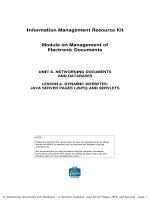Unit 04 Our Customs and Traditions Lesson 4 Communication
Bạn đang xem bản rút gọn của tài liệu. Xem và tải ngay bản đầy đủ của tài liệu tại đây (1.04 MB, 15 trang )
<span class='text_page_counter'>(1)</span>Good morning! Everybody.
<span class='text_page_counter'>(2)</span> Label the pictures with the phrases in the box: 1. a. Giving presents at Christmas. 3. b. Cleaning the house.. 2. c. Eating moon cakes at the Mid-Autumn Festival. d. Living with grandparents. 4.
<span class='text_page_counter'>(3)</span> UNIT 4:. Our Customs and Traditions. Period 31: Communication..
<span class='text_page_counter'>(4)</span> EXTRA VOCABULARY - fork [fɔ:k] (n): - prong [prɔη] (n): - tray [trei] (n): - mat [mæt] (n):. Cái dĩa Đầu dĩa Cái mâm Cái chiếu. - cutlery ['kʌtləri] (n): Bộ đồ ăn (thìa, dĩa, dao) - palm [pɑ:m] (n): Lòng bàn tay - host/hostess (n): Ông chủ/ Bà chủ.
<span class='text_page_counter'>(5)</span> 1. Discuss the difference between them. 1. Picture 1: People are sitting on the mat to have meal and using rice bowls, chopsticks and plates. 2. Picture 2: People are sitting around the dining table and using cutlery and plates..
<span class='text_page_counter'>(6)</span> 2. Read the following sentences about table manners in Britain. Work in pairs. Write T (true) or F (false). 1. The knife is held in the left hand and the folk is held in the right hand. 2. You shouldn’t point the prongs of the folk up-wards during the meal. 3. People use the same cutlery to eat the main course and the dessert. 4. When the meal is finished, you should place the knife and folk on the plate. 5. You can use your fork to take more food from the serving dish. 6. You should use your knife to cut the bread. 7. Guests should start eating before the host starts eating. 8. You should ask someone to pass you a dish..
<span class='text_page_counter'>(7)</span> 3. Now listen to Nick giving a presentation on table manners in Britain and check your answers..
<span class='text_page_counter'>(8)</span> Listen and check your answers. T. 1. The is held You knife hold the forkininthe theleft lefthand handand andthe thefork knifeisinheld the in the right hand. right 2. You shouldn’t point the prongs of the fork upwards during the meal. 3. There also spooncutlery and a fork forthe dessert. Peopleisuse thea same to eat main course and the dessert. 4. When the meal is finished, you should place the knife and fork on the plate. 5. You should can usenever your fork to take more foodtofrom use your own cutlery takethe more serving dish. food from the serving dish – use the serving spoon. 6.You should break use your offknife the bread to cutwith the your bread.hands. 7.Guests have tostart waiteating until the host host or hostess starts eating. should before starts eating. 8. You should ask someone to pass you a dish.. F F. T F T. F F F T.
<span class='text_page_counter'>(9)</span> 4. Work in pairs. Discuss if you follow these table manners in your family. Are there other table manners you follow?. 1. We sit around a tray on a mat to have meal. 2. We use rice bowls and chopsticks. 3. When chewing food, we shouldn’t talk. 4. The host/hostess invites everybody to start eating. 5. The host/ hostess offers to serve the food for the guests. 6. When we have finished eating, we place our chopsticks on the top of rice bowl..
<span class='text_page_counter'>(10)</span> 5. There is a British exchange student in your class. You invite her to dinner at your home. Play the following roles.. You are Minh. You invite your British friend to come for dinner. She asks a lot of questions about Vietnamese table manners.. You are Jessica from Britain. You want to learn about Vietnamese table manners, so you can feel comfortable at dinner. You compare these with British table manners.. Start the role- play like this: Minh: Hey Jessica! My family would like to invite you to dinner. Jessica: Oh! That’s nice but….I don’t know anything about Vietnamese table manners. Minh: Well. What do you want to know? Jessica: well, do you eat around the dinner table like in Britain? Minh: No, actually we sit on a mat with the food in the middle. Jessica: You’re kidding! Minh:…...
<span class='text_page_counter'>(11)</span> Rearrange the sentences to make a complete conversation. Then practice with a partner.. 1. A. Yes. There were several guests there, and we all waited until the host invited us to the table. B. No. You should wait until the host says ‘Bon appétit’ C. Last week, I had dinner with a French family and they have very interesting table manners. D. What about during the meal? E. That’s unusual! Also, I saw on TV that they use knives and forks. … F. What does it mean? G. Really? H. Can you eat as soon as you sit down at the dining table? I. It means ‘Enjoy your meal’. J. During the meal, you should put your hands on the table. My friend tells me that in France it’s impolite to rest your hands on your lap..
<span class='text_page_counter'>(12)</span> Answer key: A. Yes. There were several guests there, and we all waited until the host invited us to the table. 5 B. No. You should wait until the host says ‘Bon appétit’ C. Last week, I had dinner with a French family and they have 1 very interesting table manners. 8 D. What about during the meal? E. That’s unusual! Also, I saw on TV that they use knives and 10 forks. … 6 F. What does it mean? 2 G. Really? 4 H. Can you eat as soon as you sit down at the dining table? 7 I. It means ‘Enjoy your meal’. J. During the meal, you should put your hands on the table. My 9 friend tells me that in France it’s impolite to rest your hands on your lap. 3.
<span class='text_page_counter'>(13)</span> Practice with your partner A: Last week, I had dinner with a French family and they have very interesting table manners. B: Really? A: Yes. There were several guests there, and we all waited until the host invited us to the table. B: Can you eat as soon as you sit down at the dining table? A: No. You should wait until the host says ‘Bon appétit’ B: What does it mean? A: It means ‘Enjoy your meal’. B: What about during the meal? A: During the meal, you should put your hands on the table. My friend tells me that in France it’s impolite to rest your hands on your lap. B: That’s unusual! Also, I saw on TV that they use knives and forks. ….
<span class='text_page_counter'>(14)</span> * HOMEWORK + Learn by heart the new words. + Do exercises in the Workbook. + Prepare for: Unit 4 - Skills 1..
<span class='text_page_counter'>(15)</span> THANKS FOR YOUR ATTENTION. Goodbye! Celinne Dion – And so this is Xmax.
<span class='text_page_counter'>(16)</span>









